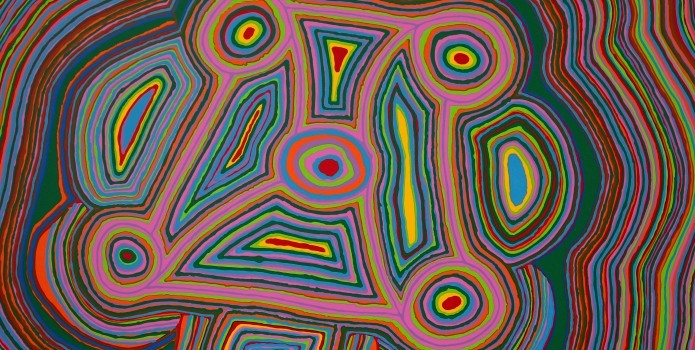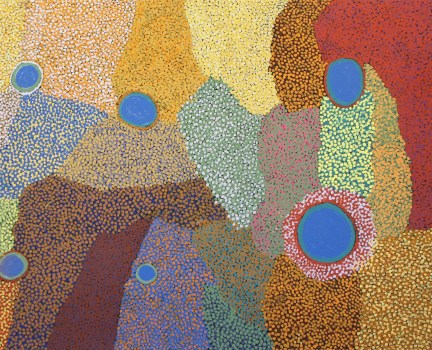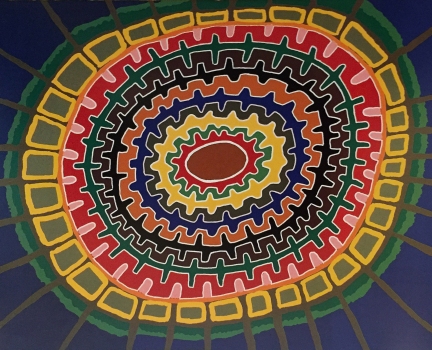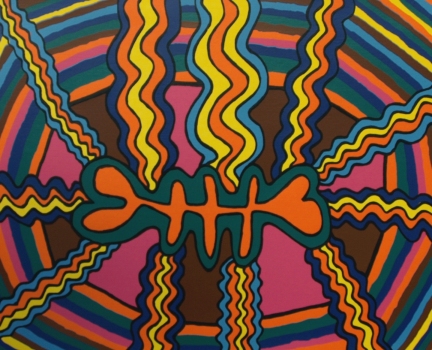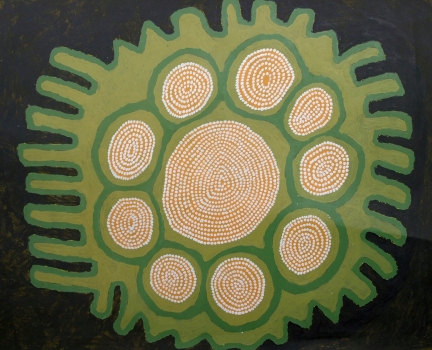Japingka Waterhole Dreaming
Water sources are sacred places to Aboriginal people of the desert, and each waterhole has a Creation story from the Dreaming attached to it. The Creation story gives the waterhole and the people who are its custodians a common bond and obligation. While traditionally Aboriginal people are nomadic in the sense that they follow the seasons in searching out native plants and hunting native animals, they stay within their own clan estates. This is the territory ‘owned’ by individual families, who have an intricate knowledge of the country and its resources. Waterholes found on their country are known precisely, from their Creation story through to the sense of whether the water will be present or drying up.
Japingka waterhole was one of the larger desert waterholes used by Walmajarri people of the Great Sandy Desert. After summer rains came to the desert it would fill up and provide enough water for the animals and the local people to gather here for a short time. During the rest of the year the people would move in small family groups to smaller waterholes, and so would not meet up with all the other groups until the next summer rains.
As a major meeting place, Japingka waterhole would be the site where all social, legal and ceremonial matters would be undertaken for the larger group. The importance of this site for Law increased its status for families of the region. While the Walmajarri people had been steadily migrating out of the desert in the decades around the 1940s, the importance of sites like Japingka waterhole travelled with them as they moved into the Fitzroy River valley. In this cattle station country the Walmajarri found new sites to carry on Law business, much like what had happened at the old desert waterholes.
Family groups associated with Japingka waterhole created some significant artists who made representations of this and other major sites from the ancestral country. Artists include Jimmy Pike (1940-2002), Paji Honeychild Yankarr (1912-2004), Peter Skipper, Penny K Lyons (b.1940), Edgar Pike (b.1945), Huey Bent and others from their extended families.
Artist Jimmy Pike represented the Creation story of Japingka waterhole showing the sandhills being formed up into ridges of clouds that surround the waterhole and bestow on it the life-giving powers over water. The site is protected by Kalpurtu, the powerful Rain Snake spirit, associated with the Rainbow Serpent. Kalpurtu is treated with great respect by people visiting this site, and must be properly addressed and the correct rituals followed.
In the later 1980s Jimmy Pike made a return visit to Japingka Waterhole which was recorded in the documentary film “The Quest of Jimmy Pike”. The waterhole had not been visited for more than three decades and had been largely re-claimed by the desert environment. Its fate was similar but not as severe as other desert waterholes, which were buried over by desert sands once the custodial people had left the area. This also had adverse effects for the native animals, because they could not access the water buried under dunes.
Japingka Gallery was named in the mid 1990s after the association to the Walmajarri desert site by artists visiting the gallery including Jimmy Pike , Peter Skipper and Huey Bent. The stories that the artists painted of the Japingka waterhole site remain as an enduring legacy of its cultural significance. Other living artists form the family group continue to paint the Japingka story, including Edgar Pike, Francine Steele and Penny K Lyons.
Read more:
View
Jimmy Pike - Art of the Great Sandy Desert
Back to Aboriginal Dreamtime Stories

